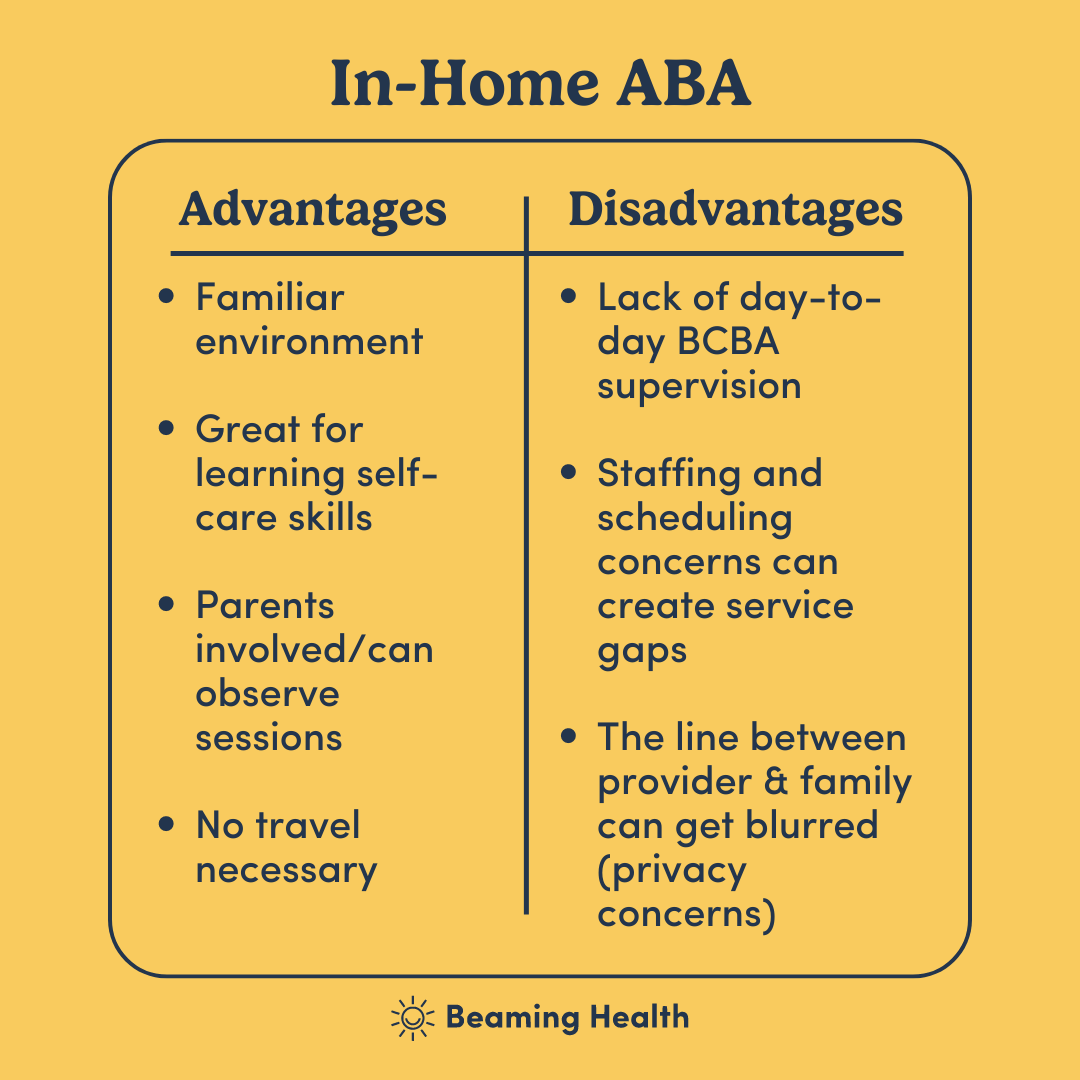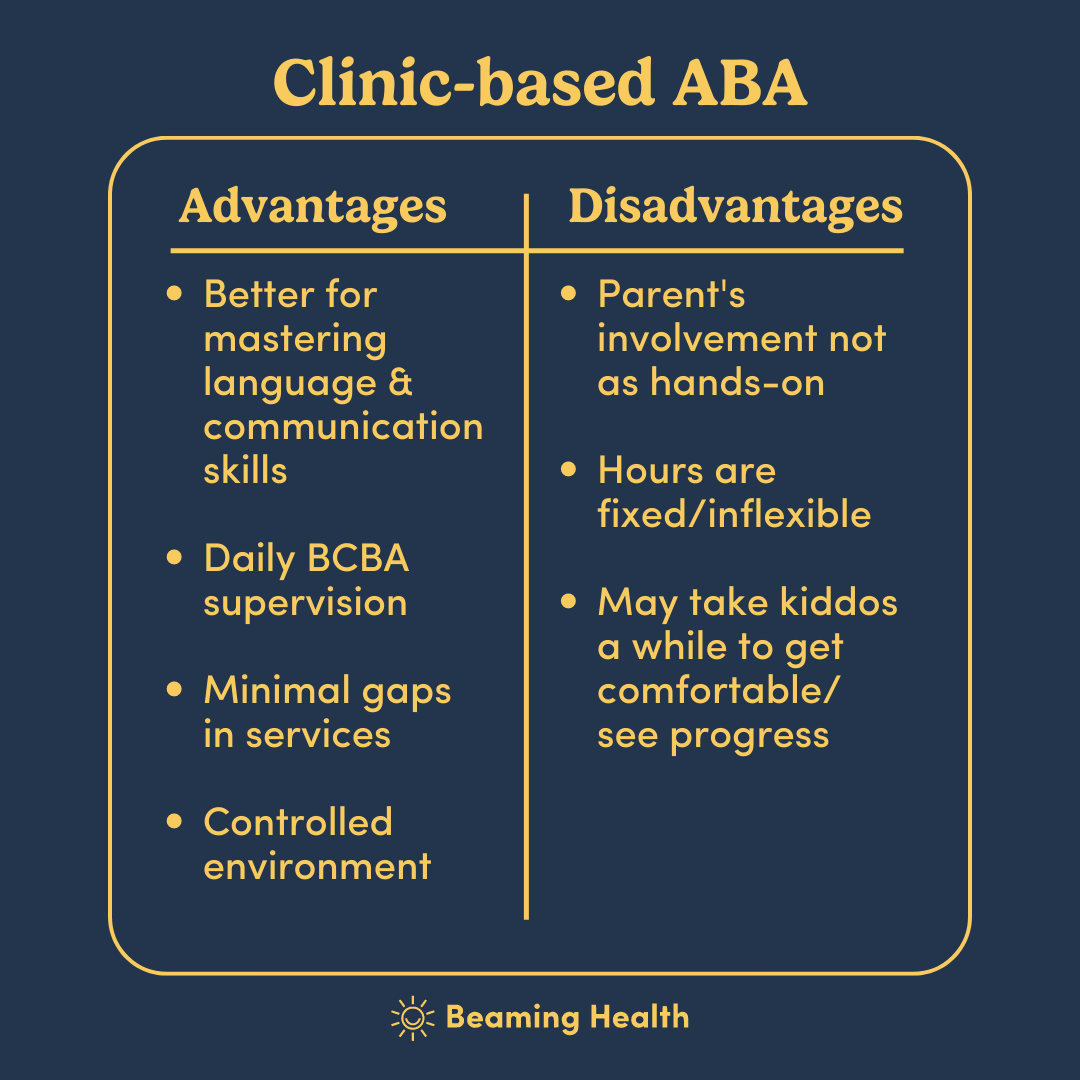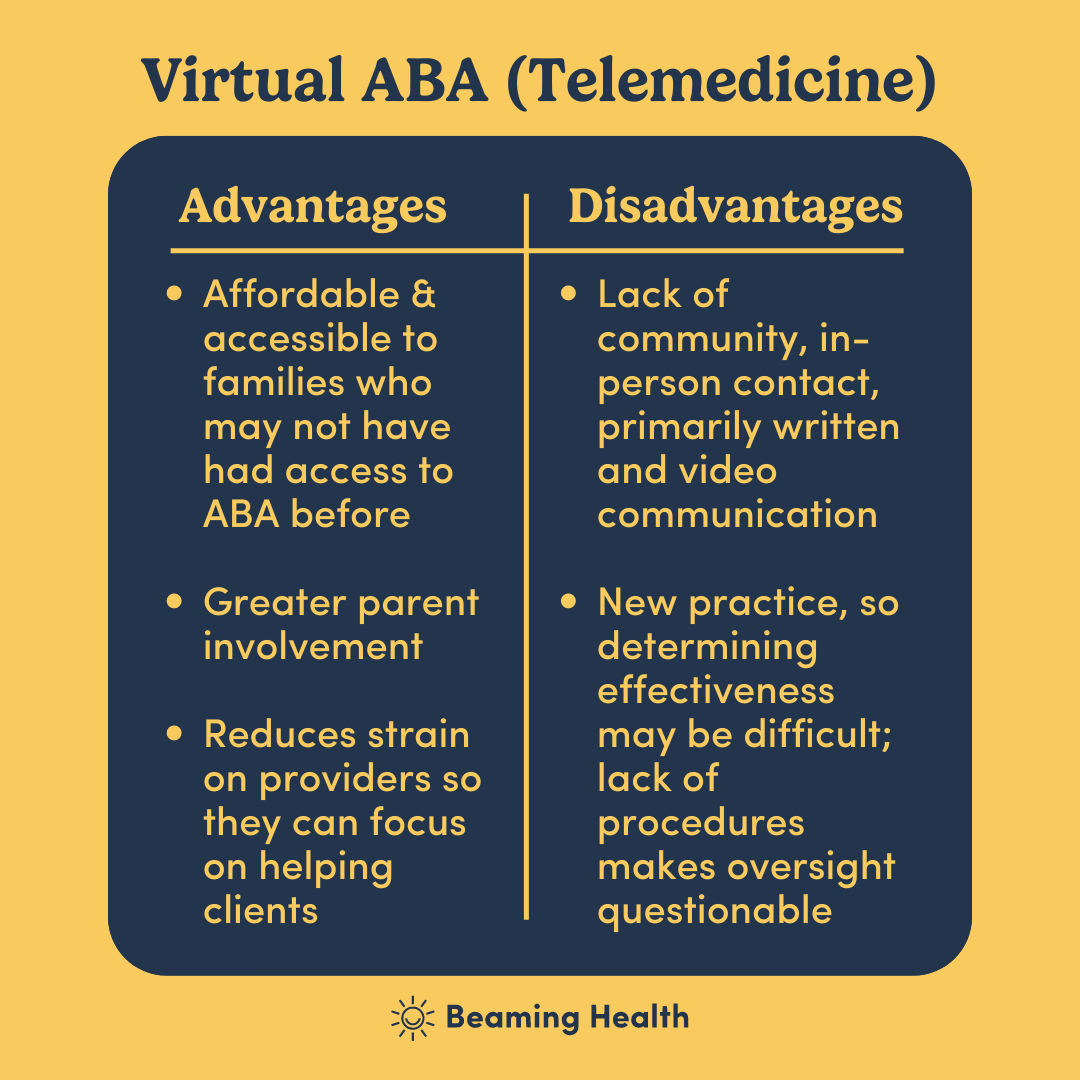ABA therapy: Is in-home or in-center better?
Updated: November 15, 2023 · 10 Minute Read

Reviewed by:
Marsha Stepensky, MS.Ed, BCBA
Highlights
- ABA (Applied Behavioral Analysis) therapy is usually available for in-person sessions at home or in a clinic. Many providers have recently offered the option for a virtual setting.
- Each option has its own benefits and disadvantages, so choosing the right one will depend on your child’s individual goals and what’s best for your family.
- At-home therapy takes place in the comfort of your own home and can help kids master day-to-day skills like grooming, as well as involve parents in coming up with solutions for challenges at home.
- Clinic-based ABA takes place in a controlled environment which can simulate situations your child might encounter in the real world, but skills don’t always transfer as easily.
- Telehealth ABA is growing in popularity, but some parents are not comfortable with this style of service since it is still new and they don’t know how effective it is.
When it comes to choosing an ABA provider, you may be wondering if your child would have a better experience in a clinical environment with other kiddos, or at home in their natural habitat. While both options have their advantages and disadvantages, there are many factors to consider when choosing which route to take for your child’s treatment goals. Online therapy, or telehealth, has also become a popular and safe option for providers and parents.1,2
Let’s dive into the pros and cons of at-home, in-clinic, and virtual ABA therapy.

ABA therapy at home
Children may learn better at home versus in a clinical environment, given that it’s comfortable and easier to learn skills in the settings you’d usually be applying them. This is especially true for daily skills you’d naturally use at home, like teeth-brushing, bedtime routines, potty training, and more.
What are the benefits of home-based ABA?
You can be more involved in sessions. One major advantage of home-based ABA therapy is that parents are present and involved for every session, a perk you don’t get with some in-clinic services. However, some parents prefer to step back and let the professionals do their thing during in-home sessions. If you choose to, you’ll have a front-row seat for your child’s therapy, allowing you to supervise and participate. Worried parents will enjoy being present to ensure their child’s safety and that the ABA is being conducted ethically. Being involved in this way is also advantageous because you’ll pick up helpful techniques and methods you can use long after your child’s therapist is gone. Parents might also find themselves with more energy to engage in therapy sessions since they are spending less time traveling to clinics.
The home might be the best learning environment for your child. It’s no surprise that kids may learn better in a comfortable, familiar environment, and there’s no place more comfortable or familiar than home! This is perhaps the biggest advantage of home-based therapy: your child will be relaxed, comfy, and ready to learn at home, whereas some kiddos may have difficulty adjusting to a clinical setting. They’ll be able to retain and master certain skills easier at home than in-clinic, so it just depends on what your goals and priorities are.
What are the disadvantages of home-based ABA?
There might be less professional supervision at your home. One challenge with in-home ABA therapy is that RBTs (Registered Behavior Technicians) working one on one with your child have less supervision than they would in a clinical setting. This can make it hard for parents and supervisors, typically BCBAs (Board Certified Behavior Analysts), to gauge whether the therapies are being performed correctly and the treatment plan is followed properly. In other words, how can you be sure the services you’re getting are the best possible?
It’s harder to set boundaries and keep your home private. Another concern with in-home ABA therapy is how easy it is for privacy lines and boundaries between personal and professional life to become blurred. When you’ve got RBTs and BCBAs coming in and out of your home, you’re forming relationships with them, and it can be natural to feel like they’re “part of the family”. This can cause problems down the line when personal relationships commingle with professional ones (e.g. family members dating RBTs, personal disagreements, etc). You or your child may also develop an attachment to a specific clinician, which could make transitioning to a new one more difficult. Some families may find the separation between home and clinic helpful for this reason.
You’ll need to get clear about how the team handles case management. If you’re considering in-home ABA, you’ll want to speak at length with your child’s BCBA about how they manage their cases. What type of supervision will they provide? How many cases will they be managing alongside your child’s? What are their processes and methods for ensuring your child’s ABA is the highest quality possible? Being in a clinical environment allows BCBAs direct and daily supervision of their clients, and they can track their progress in real-time. This is an advantage that is missing for at-home services, so be sure to ask your child’s BCBA how they’ll navigate the challenge.
You’ll have less face-to-face communication with the entire staff. When considering in-home ABA therapy, you’ll want to determine how often and when you’ll be able to communicate with your child’s technicians and BCBA. How often will they be available for one-on-one therapy, parent training, or for questions you may have? How will you contact them, or can you contact them, in the event of an emergency? How will you and your BCBA determine treatment goals and document progress? When and how can you present concerns? Unlike having face-to-face contact with staff members frequently at a clinic, your providers will come to you, and you may find yourself communicating primarily over the phone or email, so you’ll want to work out communication early on.
There might be more service disruptions. In-home ABA may have more issues with staff turnover, cancellations, scheduling issues, etc. which can cause disruptions in your child’s services. This can be a frustrating experience for parents and isn’t really ideal for kiddos who thrive on predictability and routine. These disruptions can also put parents in a bind when a crisis or emergency occurs. Another aspect to consider is disruptions caused by the home itself; for example, if you have multiple kiddos or activities going on at home, it may be difficult to navigate scheduling to ensure your child has a productive session.

ABA therapy in the clinic
While ABA at home can be great for adopting everyday skills and retaining them long-term, in-clinic options can help children achieve great strides in communication and overcome certain challenges by simulating out-of-home experiences (e.g. practicing riding around in a shopping cart to make trips to the store easier). It’s also great for preparing children for a school setting and developing a general sense of independence.
Some research shows that children obtain greater mastery of certain skills in a clinical setting versus at home (this can be due to some of the challenges we mentioned in the at-home section).3 One study suggests that in-clinic ABA therapy allows children to master skills faster than at home, probably due to the structured environment and lack of distraction.4
What are the benefits of center-based ABA?
It might be easier to master language and communication skills. One study showed that kids that received both in-home and clinic-based ABA therapy retained a 100% mastery of skills in-clinic versus at home.4 This could be because clinics are a structured learning environment and may have less distractions than learning at home. However, our clinical experts say that sometimes transferring skills learned in the clinic may be difficult because although the clinic simulates real-world situations, it’s simply not the same as learning in the environment they’ll apply the skill.
There are usually less service disruptions and a more committed staff. Unlike home-based ABA therapy, a clinical environment has less staff turnover and fewer gaps in service. You’ll have comfort knowing that your child’s appointment will be kept and therapy delivered with minimal disruptions.
You’ll receive better parent training and support in the clinic than at home. We know that parent involvement is crucial in helping autistic kiddos retain the skills they learn in therapy, but which environment is best for parents to learn in? While home-based therapy allows parents a front-row seat to their child’s session, a clinical environment may be better for training parents, getting support, and learning to apply solutions found in ABA to the child’s everyday life.4
There will be higher quality supervision. One major benefit to clinic-based ABA services is the daily BCBA supervision your child’s RBTs will receive. This means your child’s BCBA, who crafted their treatment plan and set their goals with you, will be there to offer guidance and direction to staff daily. They’ll be able to spot when things are on track as well as when your child’s therapy isn’t headed in the right direction and make needed adjustments.
What are the disadvantages of center-based ABA?
It might take some time for your child to feel comfortable. A downside of clinical ABA is that there’s an adjustment period for most kids to get comfortable in the clinic’s environment. At a good ABA clinic, the first several weeks of your child’s therapy will be a trust-building period during which your child’s care team will get to know their interests, needs, and challenges, so they can figure out how to best help and motivate them. Some parents may feel frustrated at first because it seems like there’s no change or “results” happening, but this stage is crucial for allowing your child to get their bearings in a new setting and become familiar with their therapists. Once your child is acclimated to the clinic environment and hopefully starts to enjoy time with the care team, that’s when you can start to see the fruit of their learning.
You’ll have to monitor the safety and cleanliness of the clinic. Like any space containing kids, one concern for parents will be the safety and cleanliness of the facility. Attending therapy in a clinic means your child will be exposed to the sniffles and sneezes of their new friends. When considering an ABA clinic for your child, be sure to ask about cleaning and safety procedures (how often are toys cleaned?) as well as what safety features the facility is equipped with (is the play area fenced?). If your child is an elopement risk, you’ll want to pay special attention to how the clinic manages exits and entrances, and if there are any roads or bodies of water nearby.
Skills might not transfer smoothly to the real world. Generalization is the ability for your child to apply the skills they learned in one setting to other settings. It’s not uncommon for children to do tasks independently while in a clinic, but at home, they still need a lot of support —this is likely because their skills haven’t generalized. In-clinic ABA therapy may produce “faster” results, and this is especially true the more hours of therapy a child receives in the clinic (more hours = more intensive learning). However, faster is not always better, as mastery of skills and generalization are two different metrics.

ABA therapy online (telehealth)
Due to the Covid-19 pandemic, many families and ABA providers found themselves taking things digital. For families who live in rural areas and may not have access to traditional in-home or clinic ABA options, virtual ABA therapy can be a lifesaver. Through virtual (also called “telehealth” or “telemedicine”) appointments, trained ABA providers teach parents to provide ABA to their own child. Let’s look at some advantages and disadvantages to this delivery method, based on current research.
What are the benefits of virtual ABA?
You might be more comfortable and engaged during sessions. A study that examined virtual ABA therapy providers showed that parents were able to engage and become an active part in their child’s therapy through telemedicine in a way that wasn’t seen previously (when the child was in-clinic or receiving at-home services).2 This may be because some parents are more comfortable with digital sessions than those conducted in their homes or at a clinic. Whatever the reason, BCBAs interviewed for the study noted that their clients’ parents seemed more engaged through virtual sessions.
It’s more affordable and accessible. One great aspect of virtual ABA therapy is the reduced cost to families and providers, making it one of the most affordable ABA options available today.1 Given that virtual sessions can take place from anywhere, telehealth ABA allows providers to reach families that live even in the most rural areas, providing unprecedented access to the therapy to families who need it.
Online services are less stressful on providers. BCBAs reported that conducting virtual ABA therapy sessions allowed them more time to plan and problem solve for their clients instead of worrying about day-to-day issues in the clinic or at home sessions.2 Most BCBAs have caseloads of over 10 clients at a time, so ensuring each child gets the personalized attention they need can be difficult. With telehealth, ABA providers can spend more time focusing on helping your child, and less time on all the other stuff.
It’s easier to schedule sessions. Because telehealth appointments can happen anytime, anywhere, families and providers are able to figure out schedules that work for them. This allows for less stress, more collaboration, and in some cases, a better therapy session.
What are the disadvantages of virtual ABA?
It’s hard to determine its effectiveness. The world of virtual ABA therapy is still new, so more research and planning is needed to determine best practices and how to navigate a new world of challenges for ABA providers. With that in mind, it’s important to note that when choosing virtual ABA services for your child, your ABA therapist will be figuring things out just as much as you are. The lack of concrete practices and procedures can make it difficult to determine if the therapy your child is getting is the best care possible, accurately determine if progress is being made, and other considerations. Because there’s no governing body for virtual ABA, you’re putting a lot of trust in your child’s provider and hoping it’ll be beneficial for your child.
You might feel that there’s a lack of community. A clear benefit of in-home or clinic-based ABA therapy is in-person interaction, either with your child’s BCBA, RBTs, or other staff. Obviously, with virtual ABA therapy services, you’re not getting that tangible, real-time communication or sense of support. While virtual ABA can be conducted using face-to-face video meetings, the majority of your communication with your child’s support team will likely be written, taking away a certain “human” element. At times, it may feel lacking in community or personality. If you choose a virtual option for your child’s ABA therapy, be sure to discuss how your provider can best support you and plan for you and your child’s long-term success.
Final Thoughts
Choosing which type of ABA therapy is right for your child will depend on your child’s comfort level, goals, and needs. But it’s important to note that regardless of which type of ABA you choose, parental participation is a key factor in experiencing long-term success.5 This means carrying over the techniques and methods your BCBA is using in therapy and applying them at home on a consistent basis.
Get our best articles delivered to your inbox each month.
We respect your privacy.
Dive Deeper
Article References
- Lindgren S, Wacker D, Suess A, et al. Telehealth and Autism: Treating Challenging Behavior at Lower Cost. Pediatrics. 2016;137 Suppl 2(Suppl 2):S167-S175. doi:10.1542/peds.2015-2851O
- Dueñas AD, D’Agostino SR. Experiences of service providers in the expedited delivery of ABA therapy via telehealth during the COVID-19 pandemic: Reflections and considerations for the future. Behavior Analysis: Research and Practice. July 2022. doi:10.1037/bar0000251.supp (Supplemental)
- Yu Q, Li E, Li L, Liang W. Efficacy of Interventions Based on Applied Behavior Analysis for Autism Spectrum Disorder: A Meta-Analysis. Psychiatry Investig. 2020;17(5):432-443. doi:10.30773/pi.2019.0229
- Dixon DR, Burns CO, Granpeesheh D, Amarasinghe R, Powell A, Linstead E. A Program Evaluation of Home and Center-Based Treatment for Autism Spectrum Disorder. Behav Anal Pract. 2016;10(3):307-312. Published 2016 Oct 25. doi:10.1007/s40617-016-0155-7
- Molko R. Author Post: Home-Based Vs. Center-Based Services for Autism. Forbes. Accessed August 4, 2022. https://www.forbes.com/sites/forbesbooksauthors/2019/05/24/home-based-vs-center-based-services-for-autism/?sh=2f3b04391d35
- Dennison A, Lund EM, Brodhead MT, Mejia L, Armenta A, Leal J. Delivering Home-Supported Applied Behavior Analysis Therapies to Culturally and Linguistically Diverse Families. Behav Anal Pract. 2019;12(4):887-898. Published 2019 Jul 18. doi:10.1007/s40617-019-00374-1













